coolant level CHEVROLET CAMARO 1993 Owners Manual
[x] Cancel search | Manufacturer: CHEVROLET, Model Year: 1993, Model line: CAMARO, Model: CHEVROLET CAMARO 1993Pages: 358, PDF Size: 15.6 MB
Page 109 of 358
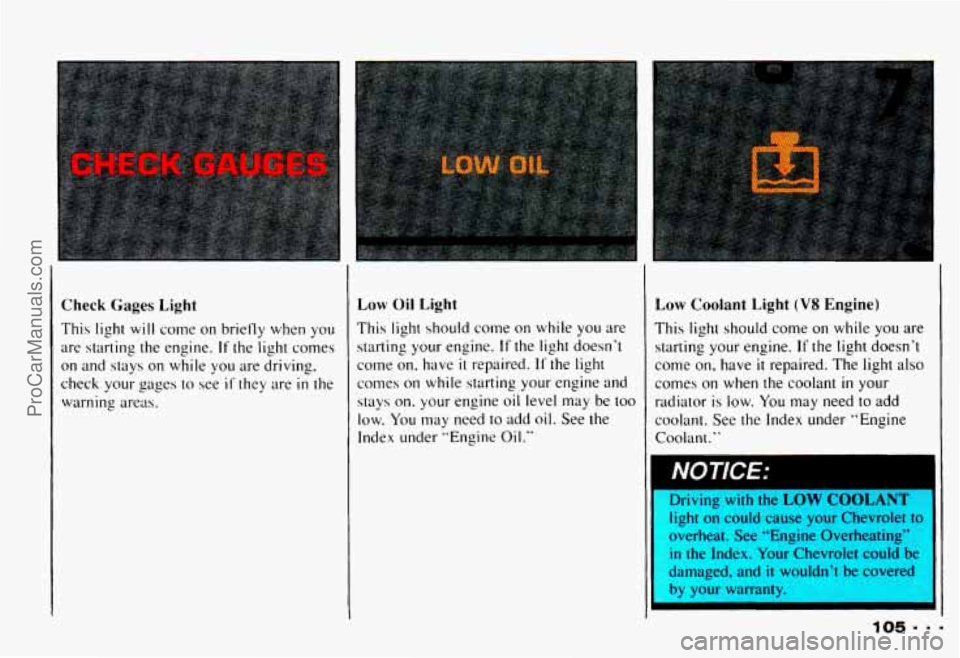
Check Gages Light
This light will come on briefly when you
are starting the engine.
If the light comes
on and stays
on while you are driving.
check your gages
to see if they are in the
warning areas.
Low Oil Light
This light should come on while you are
starting your engine.
If the light doesn’t
come on. have
it repaired. If the light
comes on while starting your engine and
stays on. your engine
oil level may be too
low. You may need to add oil. See the
Index under “Engine
Oil.“
Low Coolant Light (V8 Engine)
This light should come on while you are
starting your engine.
If the light doesn’t
come on, have
it repaired. The light also
comes on when the coolant
in your
radiator is low.
You may need to add
coolant. See
the Index under “Engine
Coolant.“
.. Drtvlng wilt Lllr uw vv wwvuIIA I’
light on could cause your Chevrolet tc
overheat. See “Engine Overheating”
in the Index. Your Chevrolet could be
damaged, and
it wouldn’t be covered
by your warranty.
ProCarManuals.com
Page 115 of 358
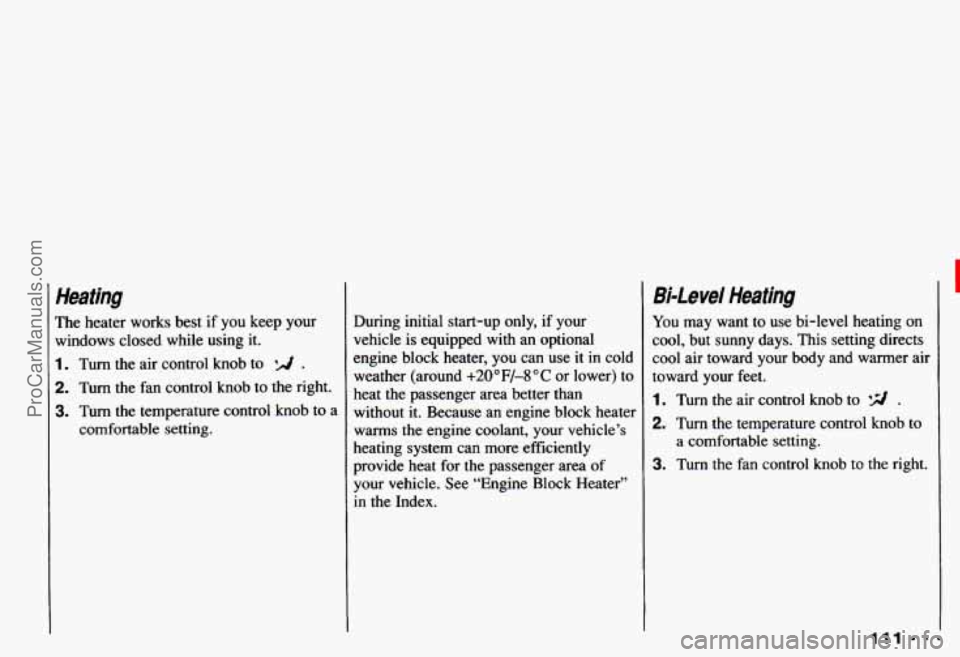
Heating
The heater works best if you keep your
windows closed while using it.
1. Turn the air control knob to .
2. Turn the fan control knob to the right.
3. Turn the temperature control knob to a
comfortable setting.
I
During initial start-up only, if your
vehicle is equipped
with an optional
engine block heater,
you can use it in cold
weather (around
+20°F/-8 “C or lower) to
heat the passenger area better than
without it. Because an engine block heater
warms the engine coolant, your vehicle’s
heating system can more efficiently
provide heat for the passenger area
of
your vehicle. See “Engine Block Heater”
in the Index.
Bi-level Heating
You may want to use bi-level heating on
cool, but sunny days. This setting directs
cool air toward your body and warmer air
toward your feet.
1. Turn the air control knob to *2 .
2. Turn the temperature control knob to
3. Turn the fan control knob to the right.
a comfortable setting.
111 .
ProCarManuals.com
Page 200 of 358

Problems on the Road
I. -
.. .
On the V8 engine you’ll see this:
1. Coolant recovery tank
2. Radiator pressure cap
3. Electric engine fans
An electric fan under the hood
L can start up even when the
engine
is not running and can injure
you. Keep hands, clbthing and tools
away from any underhood electric
fan.
... 196
I I
If the coolant inside the coolant recovery
tank
is boiling, don’t do anything else
until it cools down.
When
it is cool, remove the coolant
recovery tank cap and
look at the dipstick. I I
The coolant level should be at or above
FULL COLD. If it isn’t, you may have
a leak
in the radiator hoses, heater hoses,
radiator, water pump or somewhere else
in the cooling system. II
A Heater and radiator hoses, and
L other engine parts, can be very
hot. Don’t touch them.
If you do,
you can be burned. ~
Don’t run the engine if there is a
leak. If
you run the engine, it could
lose
all coolant. That could cause
an engine fire, and you could be
burned. Get any leak fixed before
you drive the vehicle.
ProCarManuals.com
Page 201 of 358
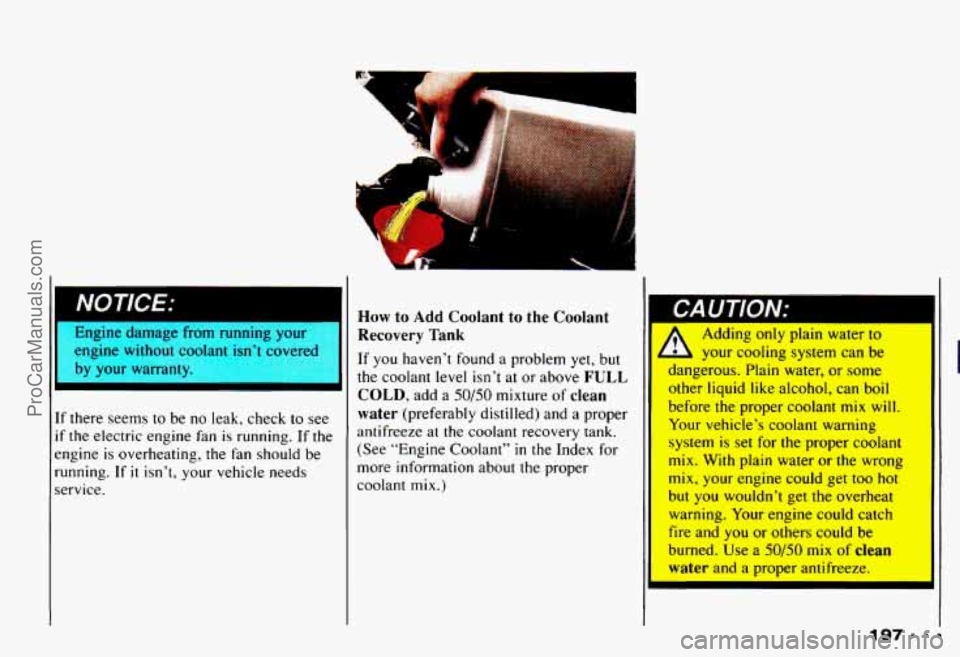
eng~ witho
r
u -.. .
tolar .-
[f there seems to be no leak, check to see
f the electric engine fan is running. If the
:ngine is overheating, the fan should be
-unning.
If it isn’t, your vehicle needs
iervice.
I I
How to Add Coolant to the Coolant
Recovery Tank
If you haven’t found a problem yet, but
the coolant level isn’t
at or above FULL
COLD,
add a 50/50 mixture of clean
water
(preferably distilled) and a proper
antifreeze at the coolant recovery tank.
(See “Engine Coolant”
in the Index for
more information about the proper
coolant
mix.)
A Adding only plain water to
L your cooling system can be
dangerous. Plain water, or some
I
other liquid like alcohol, can boil
before the proper coolant
mix will.
Your vehicle’s coolant warning
system
is set for the proper coolant
mix. With plain water or the wrong
mix, your engine could get too hot
but you wouldn’t get the overheat
warning. Your engine could catch
fire and you or others could
be
burned. Use a 50/50 mix of clean
water
and a proper antifreeze.
197-
ProCarManuals.com
Page 204 of 358
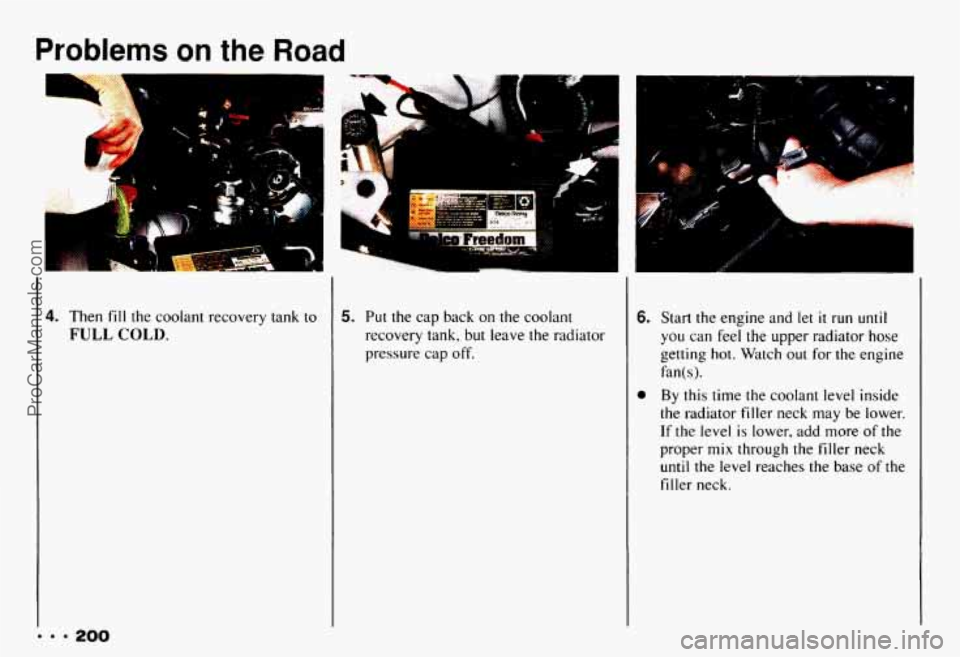
Problems on the Road
4. Then fill the coolant recovery tank to
FULL COLD.
... 200
.A 1
5. Put the cap back on the coolant
recovery tank, but leave the radiator
pressure cap off.
i
6.
0
Start the engine and let it run until
you can feel the upper radiator hose
getting hot. Watch out for the engine
fan( s).
By this time the coolant level inside
the radiator filler neck
may be lower.
If the level is lower, add more of the
proper
mix through the filler neck
until the level reaches the base of the
filler neck.
ProCarManuals.com
Page 207 of 358
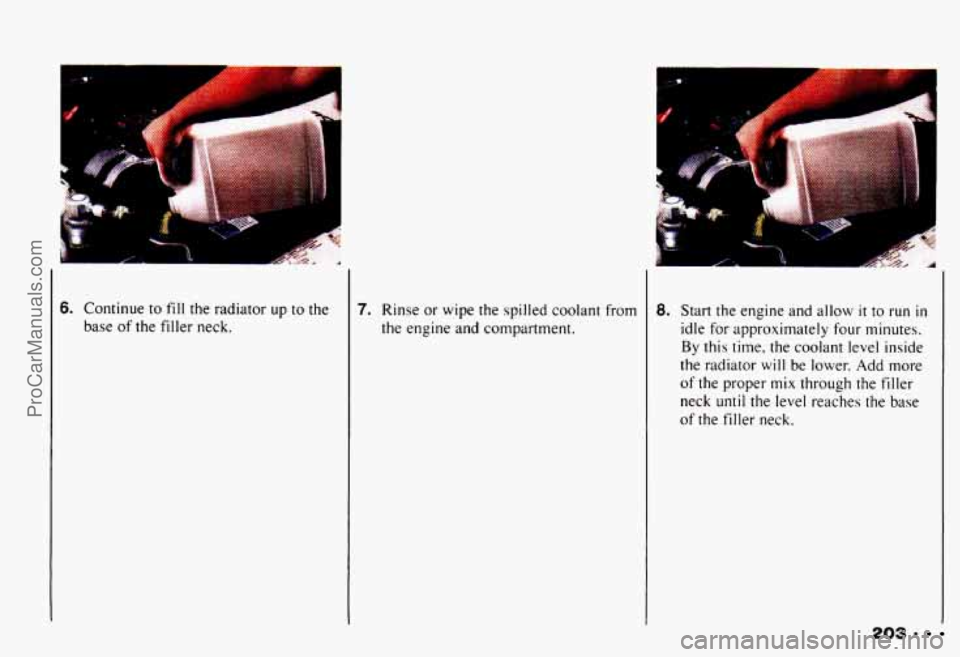
6. Continue to fill the radiator up to the
base
of the filler neck.
7. Rinse or wipe the spilled coolant from
the engine and compartment.
A I
8. Start the engine and allow it to run in
idle for approximately four minutes.
By this time, the coolant level inside
the radiator
will be lower. Add more
of the proper mix through the filler
neck
until the level reaches the base
of the filler neck.
203 9
ProCarManuals.com
Page 208 of 358

Problems on the Road
I lh
1
F. $. '
9. Shut the engine off and replace the
pressure cap. Be sure the arrows
on
the cap line up like this.
Y CI.
10. Then fill the coolant recovery tank
For a complete drain. flush and refill, see
your Chevrolet dealer or a Chevrolet
Carnaro Service
Manual. To purchase
a service manual, see "Service
Publications"
in the Index.
to the proper level.
If a Tire Goes Flat
It's unusual for
a tire to "blow out" while
you're driving, especially
if you maintain
your tires properly.
If air goes out of a
tire, it's much more likely
to leak out
slowly.
But if you should ever have a
"blowout," here are a few tips about what
to expect and what to do:
If a front tire fails, the flat tire will create
a drag that pulls the vehicle toward that
side. Take your foot off the accelerator
pedal and grip the steering wheel firmly.
Steer
to maintain lane position, then
gently brake to a stop well out of
the
traffic lane.
ProCarManuals.com
Page 221 of 358

Part b
Here you will find information
about the care
of your Chevrolet .
This part begins with service and
fuel information. and then it shows
how
to check important fluid and
lubricant levels
. There is also
technical information about your
vehicle. and a section devoted to
its appearance care
.
Service & Appearance Care
Service .......................................................... 218
Fuel
............................................................ 219
Checking Things under the Hood
..................................... 223
HoodRelease
................................................... 223
Engineoil
...................................................... 226
Aircleaner
..................................................... 230
Automatic Transmission Fluid
...................................... 233
Manual Transmission Fluid
........................................ 235
Hydraulicclutch
................................................ 237
RearAxle
...................................................... 237
Enginecoolant
.................................................. 238
Power Steering Fluid
............................................. 242
Windshield Washer Fluid
.......................................... 243
Brake Master Cylinder
............................................ 244
Battery
........................................................ 246
Bulb Replacement
................................................. 247
Loading Your Vehicle
.............................................. 255
Appearance Care and Maintenance Materials
............................ 274
Vehicle Identification Number (VIN)
.................................. 275
Service Parts Identification Label
..................................... 275
Add-on Electrical Equipment
........................................ 275
Fuses and Circuit Breakers
.......................................... 276
Replacement Bulbs
................................................ 279
Capacities and Specifications
......................................... 280
Tires
............................................................ 256
Appearancecare
.................................................. 265
217
ProCarManuals.com
Page 244 of 358
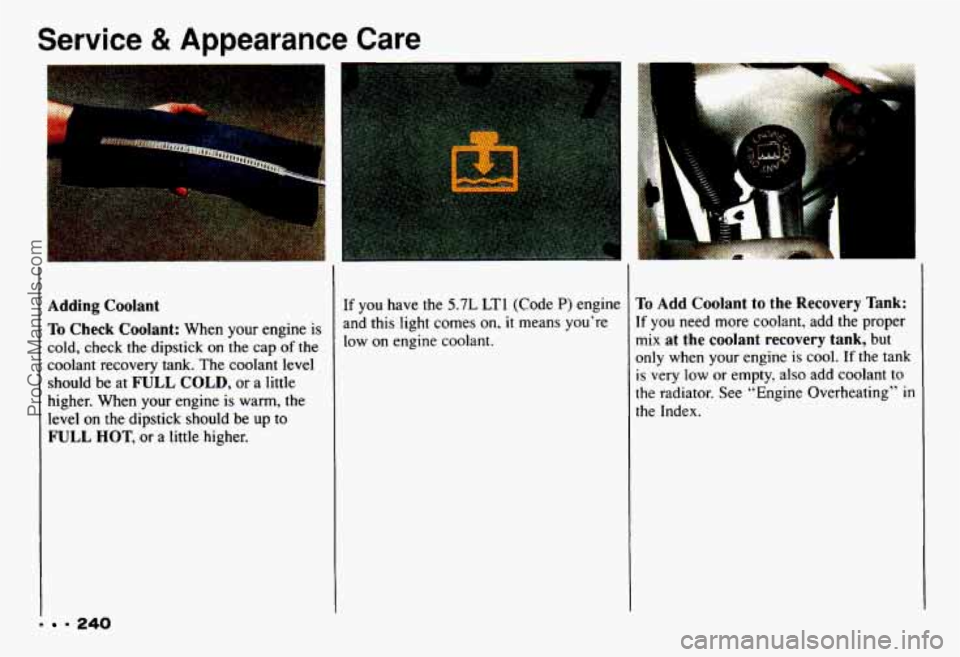
Service & Appearance Care
1
Adding Coolant
To Check Coolant: When your engine is
cold, check the dipstick on the cap of the
coolant recovery tank. The coolant level
should be at
FULL COLD, or a little
higher. When your engine is warm, the
level on the dipstick should be up to
FULL HOT, or a little higher.
If you have the 5.7L LTl (Code P) engine
and this light comes on,
it means you’re
low on engine coolant.
To Add Coolant to the Recovery Tank:
If you need more coolant, add the proper
mix
at the coolant recovery tank, but
only when your engine
is cool. If the tank
is very low or empty, also add coolant to
the radiator. See “Engine Overheating” in
the Index.
9 240
ProCarManuals.com
Page 246 of 358
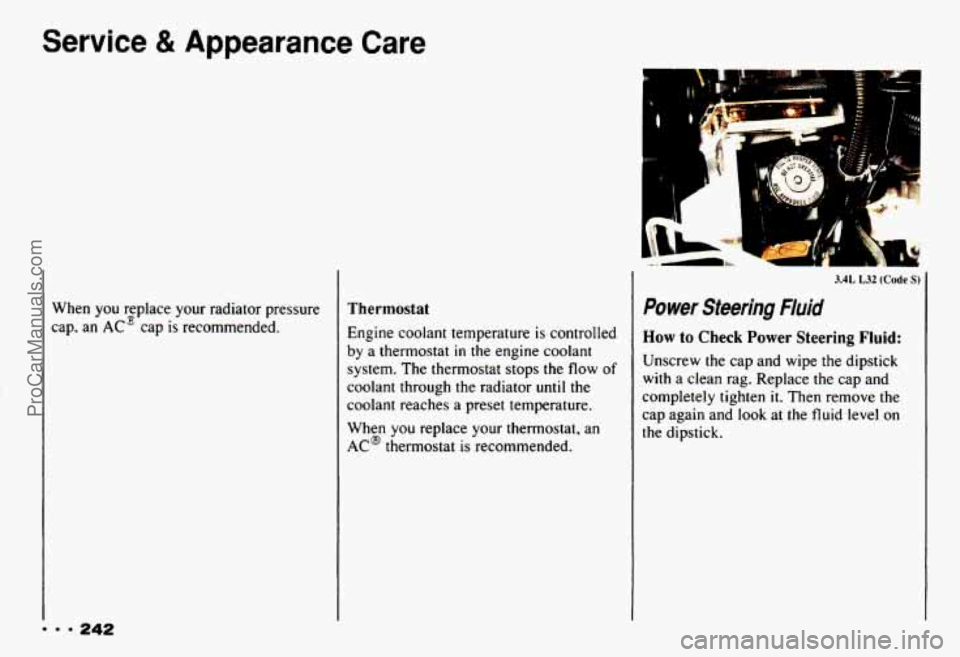
Service & Appearance Care
When you replace your radiator pressure
cap. an
AC3 cap is recommended.
Thermostat
Engine coolant temperature is controlled
by a thermostat in the engine coolant
system. The thermostat stops the flow
of
coolant through the radiator until the
coolant reaches a preset temperature.
When you replace
your thermostat, an
AC@ thermostat is recommended.
3.4L L32 (Code S)
Power Steering Fluid
How to Check Power Steering Fluid:
Unscrew the cap and wipe the dipstick
with a clean rag. Replace the cap and
completely tighten
it. Then remove the
cap again and look at the fluid level
on
the dipstick.
ProCarManuals.com